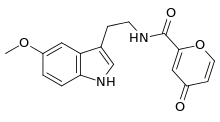Piromelatine
Piromelatine (Neu-P11) is a multimodal sleep drug under development by Neurim Pharmaceuticals. It is an agonist at melatonin MT1/MT2 and serotonin 5-HT1A/5-HT1D receptors. Neurim is conducting a phase II randomized, placebo controlled trial of cognitive and sleep effects in Alzheimer's disease.
 | |
| Identifiers | |
|---|---|
IUPAC name
| |
| CAS Number | |
| PubChem CID | |
| ChemSpider | |
| CompTox Dashboard (EPA) | |
| Chemical and physical data | |
| Formula | C17H16N2O4 |
| Molar mass | 312.32 g/mol g·mol−1 |
| 3D model (JSmol) | |
SMILES
| |
InChI
| |
Results of a phase II trial on insomnia in 120 adults were announced in 2013, finding piromelatine 20/50 mg improved sleep over 4 weeks vs placebo.[1] Phase 1A/1B studies in 2011, showed safe dose-dependent improvement in sleep.[2] Pre-clinical studies showed antinociceptive[3] antihypertensive[4] and cognitive benefits[5] in rat disease models of pain, hypertension, and Alzheimer's disease.
See also
References
- http://www.neurim.com/news/2013-02-18/positive-phase-2-clinical-trial-results-of-piromelatine-for-the-treatment-of-insomnia/
- http://www.neurim.com/news/2011-07-24/positive-results-from-phase-i-and-ib-clinical-trials-with-neu-p11/
- Liu, YY; Yin, D; Chen, L; Qu, WM; Chen, CR; Laudon, M; Cheng, NN; Urade, Y; Huang, ZL (October 2014). "Piromelatine exerts antinociceptive effect via melatonin, opioid, and 5HT1A receptors and hypnotic effect via melatonin receptors in a mouse model of neuropathic pain". Psychopharmacology. 231 (20): 3973–85. doi:10.1007/s00213-014-3530-5. PMID 24700387.
- Huang, L; Zhang, C; Hou, Y; Laudon, M; She, M; Yang, S; Ding, L; Wang, H; Wang, Z; He, P; Yin, W (September 2013). "Blood pressure reducing effects of piromelatine and melatonin in spontaneously hypertensive rats". European Review for Medical and Pharmacological Sciences. 17 (18): 2449–56. PMID 24089222.
- He, P; Ouyang, X; Zhou, S; Yin, W; Tang, C; Laudon, M; Tian, S (2013). "A novel melatonin agonist Neu-P11 facilitates memory performance and improves cognitive impairment in a rat model of Alzheimer' disease". Hormones and Behavior. 64 (1): 1–7. doi:10.1016/j.yhbeh.2013.04.009. PMID 23651610.
This article is issued from
Wikipedia.
The text is licensed under Creative
Commons - Attribution - Sharealike.
Additional terms may apply for the media files.